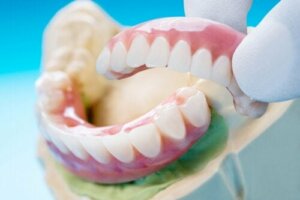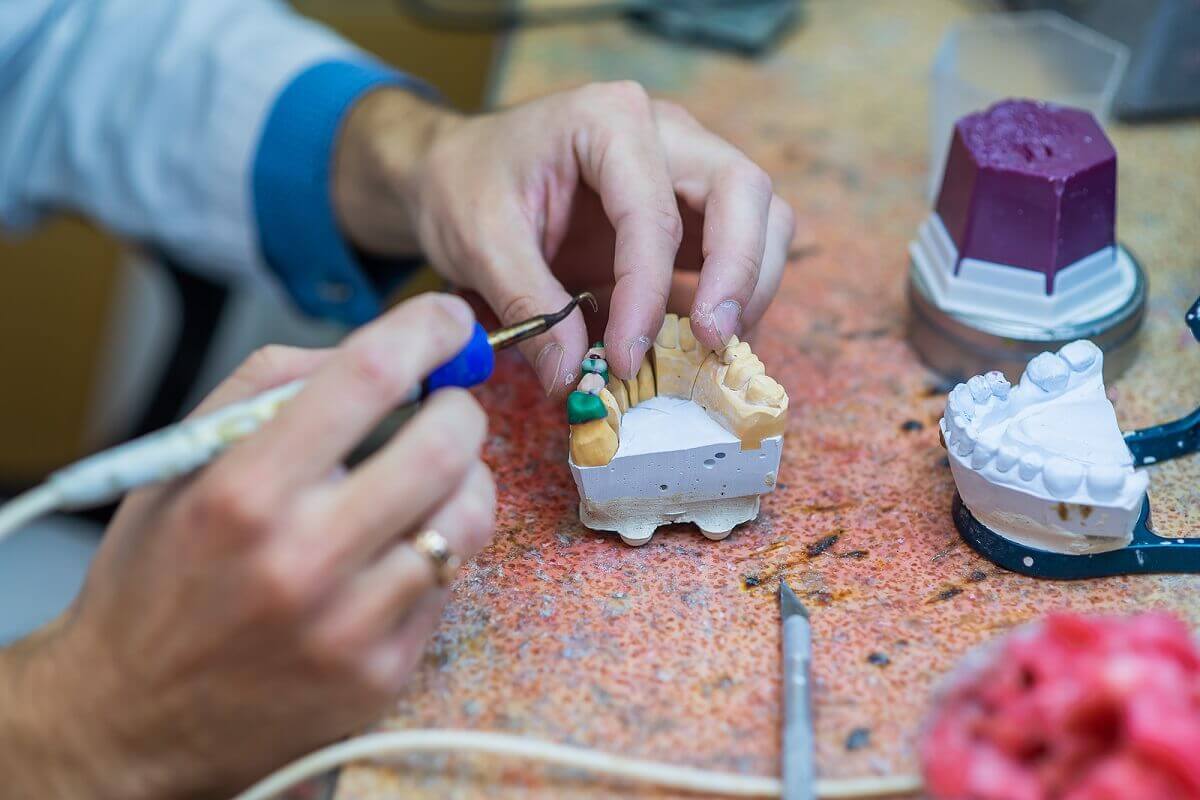Dental Bridge: Types, Benefits, and Disadvantages


Written and verified by the dentist Vanesa Evangelina Buffa
When facing a lack of dental elements in the mouth, the orthodontist may suggest fitting a dental bridge. This is an alternative that allows the wearer to recuperate the esthetics and the functions that they lost along with their teeth.
But what does it consist of? What are the advantages and disadvantages of this device?
There are many questions about dental bridges. In this article, we’ll explain what dental bridges are, the types available, and the main benefits.
Keep reading!
What is a dental bridge?
A dental bridge is a type of fixed prosthesis that we use to replace one or several dental elements together that are absent from the mouth. Particularly, this covers the zone that’s missing teeth with artificial crowns that adhere to the healthy teeth that the person still has.
Now, so the dental bridge stays attached to its neighboring dental pieces, they should be carved beforehand. This means that the teeth have to be filed so that the structure can be cemented on them accordingly. This, therefore, means that the patient can’t remove the prosthesis as it has been fixed in the mouth.
With this type of rehabilitation, the patient can recuperate functions that they may have lost along with one or more teeth. Among those, we find esthetics, obstruction, the ability to chew, the shape of the face, speech, and pronunciation.
In general, dental bridges can be made from the following materials:
- Metals
- Resins
- Ceramic
- Porcelain
- Ceromers (ceramic-optimized resin)

Like this article? You may also like reading: LED Teeth Whitening: Advantages, Disadvantages, and Care
How do they make dental bridges?
After the orthodontist has carried out the diagnostic and has decided, in agreeance with the patient, to solve the absence of some dental elements by fitting a dental bridge, these are the steps that they’ll follow to do so:
- Carve the remaining teeth: Under anesthesia, the orthodontist will file down the neighboring dental pieces with the turbine. These teeth are then called pillars since they support the bridge.
- Take the impression: The orthodontist will take molds of the mouth to then send them to the dental laboratory, where other specialists will make the bridge.
- Provisional resin: Depending on the diagnostic model, provisional crowns will be made to fit over the filed-down pillars during the time it takes to create the bridge. As such, the esthetic and health of the worn elements are preserved.
- Metal test: Here, the metallic structure of the bridge is tested; the orthodontist tests if it has been adjusted well or if it needs to be corrected.
- Colour test: The orthodontist takes the patient’s color and sends it to the laboratory again.
- Bridge test: The orthodontist then tests the bridge in its entirety and makes the corresponding adjustments. They then send the bridge one last time to the laboratory to be finished and shined.
- Sticking the bridge: The orthodontist covers the filed pillars in special cement and then fixes it in the mouth.
- Subsequent checks: After a period of use, the orthodontist will arrange another date to check that everything is in order.
What types of dental bridges are there?
There are different types of dental bridges. The main ones are the more traditional kinds, the cantilever, Maryland, and those supported by implants. The choice of which depends on the specifics of the case. The orthodontist will be able to guide the process, according to the needs of the individual.
Traditional dental bridge
The traditional dental bridge is one that’s used when there are natural dental elements on each side of the empty space. As such, the space is filled by one or several artificial teeth that hold(s) the crowns that have cemented to both sides over the dental pillars.
Having pillars on both sides is the best option for the distribution of and support for the impact of chewing. For that reason, it’s common to have these at the back of the mouth.
Cantilever dental bridge
The Cantilever dental bridge is similar to the traditional bridge, with the difference of only having one pillar to hold on to.
Thus, in these cases, the procedure will only require one natural tooth that neighbors the space generated by the absent dental elements.
The orthodontist will have to file the chosen tooth into a pillar. They will then cement the crown along with the bridge onto it, which will subsequently allow the artificial tooth/teeth to occupy the empty space. Only having one supporting point, there should be less resistance.
Sometimes, teeth can fracture or come off entirely due to a lever-like structure that is formed when the individual is chewing.
Maryland dental bridge
Maryland dental bridges use two natural dental elements, like pillars, one on each side of the empty space. The difference with these in comparison to the traditional ones is that they don’t use crowns over the pillars, but some side fins, made from metallic or porcelain, adhere to the rear surface of the neighboring teeth.
In order to do this, it’s essential to have a natural element on both sides of the space created by the missing dental pieces. In this case, the orthodontist won’t need to file the teeth as much, making it the most conservative option.
Either way, this kind of bridge is only for areas that aren’t subjected to high occlusal load, since they can’t withstand impacts.
Implant-supported dental bridge
As the name suggests, these bridges use implants instead of crowns over the filed teeth. To fit the implants that’ll later support the bridge, the patient must undergo surgery.
In general, there’ll be two separate surgeries: one to fit the implants and another to fit the bridge. This process can take months to finish.
The amount and placement of the implants will vary according to the specific case. For example, your dentist could place your implant in the center of the space, and give you one per missing element or one at each end of the gap.
This type of dental bridge is the most stable and can best support heavy force. It’s also usually the most comfortable for the person, and the only one that prevents bone reabsorption from the empty space.
The benefits of dental bridges
Fitting a dental bridge has as many esthetic benefits as well as health benefits.
Once the process is complete, the person can return to eating and chewing normally. Furthermore, their pronunciation will improve since they will no longer have spaces that can cause involuntary sounds, syllables, or other linguistic habits.
From an esthetic point of view, having all your teeth present in your mouth can help with confidence and self-esteem; it prevents teasing and improves the physical appearance by maintaining the face’s shape. Likewise, by filling the empty space of the lost teeth, the other teeth are less likely to move and change position.
The cost of the dental bridge is one of its most noticeable advantages. They’re durable and in comparison to implants, a lot more budget-friendly.

We think you may also like to read this article: 9 Natural and Effective Tips for Taking Care of Your Teeth
The disadvantages of dental bridges
Before resorting to a dental bridge as a solution to missing teeth, it’s essential you know some of the disadvantages of this method.
Below, we’ll highlight a few:
- Wearing down the dental pillars: The main disadvantage of this type of prosthesis is the fact that filling healthy teeth is necessary. Wearing down these teeth increases the risk of suffering other damages in the process, and in certain cases, the patient needs to have a root canal. On the other hand, given its change in shape, these pieces must always be covered by a crown.
- Esthetic: Doing this process with metal can cause staining to the tooth.
- Risk of leaking: The space between the pillar and the crown can sometimes cause cavities below the crown.
- Risk of movement: The pillars can move, especially if they bear a heavy load during chewing. Specialists don’t recommend using them in patients that have harmful habits like bruxism (teeth grinding), or biting objects or their nails.
- Bone reabsorption: As the bones where there aren’t dental elements aren’t stimulated, the body reabsorbs them.
- Durability: Dental bridges usually last for several years in the mouth, but when comparing them to implants, they don’t last as long.
- Risk of gingivitis: Bacteria can accumulate in the space between the bridge and the gums, which causes inflammation of the latter.
Talk to your orthodontist for more information
Dental bridges can be a good option to replace those teeth that are missing from the mouth. However, before choosing this method, it’s important to consult an orthodontist.
The orthodontist will help to resolve your doubts about the materials, types, designs, and bonds. They’ll also evaluate any potential inconveniences. Keep that in mind!
All cited sources were thoroughly reviewed by our team to ensure their quality, reliability, currency, and validity. The bibliography of this article was considered reliable and of academic or scientific accuracy.
- Carrillo Mendoza, Daniel Israel. Diagnóstico, pronóstico y plan de tratamiento de un puente fijo. BS thesis. Universidad de Guayaquil. Facultad Piloto de Odontología, 2016.
- Valenzuela Reyes, Adriana Janeth. Puente Maryland en el sector anterior. BS thesis. Universidad de Guayaquil. Facultad Piloto de Odontología, 2016.
- Huang, Wan-Ting, and Han-Yi Cheng. “Finite Element Analysis of Stress in Dental Bridge with Implant.” Journal of Biomaterials and Tissue Engineering 10.6 (2020): 743-748.
- Urías Johnson, Eddy José. Evaluación de la profundidad de filtración in vitro en la interfase entre tejido dental y los materiales de obturación y cementación temporal,(utilizados en la Facultad de Odontología de la Universidad de San Carlos de Guatemala), sometidos al proceso de termociclaje para simular las condiciones del ambiente bucal. Diss. Universidad de San Carlos de Guatemala, 2019.
- Bustillos Díaz, Natalí Dayana. Relevancia del cemento en la estabilidad del color en restauraciones vitro cerámicas. Reporte de caso. BS thesis. Universidad de Guayaquil. Facultad Piloto de Odontología, 2019.
- Maldonado Pineda, María Belén. Retratamiento endodóntico en diente con filtración por inadecuada adapatación prótesica. BS thesis. Universidad de Guayaquil. Facultad de Piloto de Odontología, 2016.
- Village, Cheadle. “Dental Bridge Treatment Cheadle| Cosmetic Bridge| Cheadle Dental Practice.” (2017).
- Alharby, Amal, et al. “Parafunctional behaviors and its effect on dental bridges.” Journal of clinical medicine research 10.2 (2018): 73.
This text is provided for informational purposes only and does not replace consultation with a professional. If in doubt, consult your specialist.








